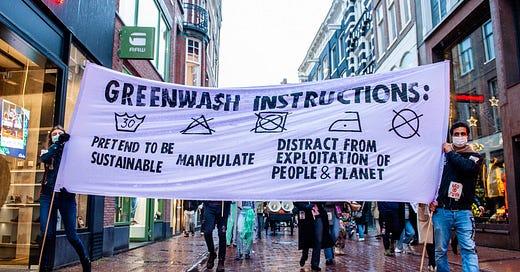Are Certifications the Future of Fashion or a Greenwashing Tactic?
A new report seems to suggest the latter.

*This Stuff is a newsletter by me! fashion journalist, Alyssa Hardy. Three times a week, I unpack the ways our clothes impact the world through news, essays, interviews and more. Subscribe for free here and follow me on Instagram, Facebook and Twitter. Know someone who might like this story? Forward it to them!*
As we head into Earth Month this April, fashion brands around the world are gearing up to push their sustainability claims to the masses. We’ll hear about new technologies in textiles, reducing carbon emissions and waste, upcycling, recycling, and everything in between. There will be tips and posturing about which brands are doing it right and which ones are doing it wrong. Importantly, brands that have taken the necessary steps toward certification for their sustainability claims will get an added dose of attention as they tout their sustainable badges of honor.
While it’s great that so many brands seem to be working toward change, and finding ways outside of a simple marketing campaign to highlight them, the issue is that certifications in fashion are not always what they’re cracked up to be. According to a new report from The Changing Markets Foundation, many of the top certifications and auditing systems are not making tangible changes to fashion and instead are adding to the ever-growing greenwashing problem within the industry.
The report, titled, “License to Greenwash,” compares 10 major certifications in fashion including bluesign®, Higg Index, Cradle to Cradle (C2C), EU Ecolabel, OEKO-TEX®, Textile Exchange, The Ellen MacArthur Foundation (EMF), The Microfibre Consortium (TMC), ZDHC, and WRAP.
One of the sections asks how each certification creates change by asking how it drives improvement, independence, transparency, and performance. Each brand was given a color coded score. Green means the problem is addressed through quantitative measures; orange indicates it’s addressed through ambitions, recommendations, reports, or not yet implemented measures; and red means it is not addressed in any meaningful way. Every certification listed, except bluesign, had at least one section that was red. Most had only one green rating if any at all. It’s important because accountability is arguably one of the biggest issues in fashion. It is a wildly under regulated industry, and certifications are voluntary – making enforcement difficult.
“Alongside lackluster environmental targets, many do not champion greater transparency or supply-chain due diligence and are limited in scope,” the report argues. It goes on to add that sometimes certifications are “exacerbating” problems because companies can hide behind them without doing the critical work needed to improve. The Higg Index, for example, is used by fast fashion brands like H&M to provide “transparency” into claims about sustainability, but the report says the lack of nuance creates confusion for consumers.
While many certifications and the work put in by brands that use them properly shouldn’t be overlooked, the strongest point made in the conclusion of the report is that there has to be both third party and government buy-in. If there is someone outside of both the brand and the certifiers verifying the claims, then it would be reasonable to trust it more. From a consumer perspective, it’s just another reminder that fashion is a business that is constantly marketing to us to buy more and more, even when they are saying it's less impactful. Skepticism about sustainability claims, even with a top tier certifier, is necessary to move forward.
In case you missed it - more from This Stuff:



